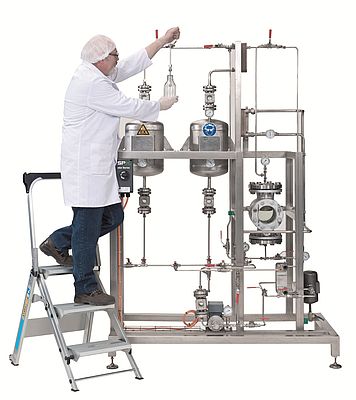The development of a new method of liquid gas extraction offers the user significant cost savings in small batch applications. The process uses Dimethyl ether (DME) to extract organic material and requires the use of only moderate pressures.
Through its e&e Series process technology, SPX has long offered some of the most efficient extraction solutions offering high yields and high quality production for materials including instant coffee, cosmetics, pharmaceuticals, and food and beverage products. A continued drive for improved efficiencies and performance has led to the development of a new method of liquid gas extraction which offers the user significant cost savings in small batch applications.
Dimethyl ether (DME), also known as methoxymethane, is an organic compound that exists as an odourless gas under atmospheric conditions. It is the simplest ether and can be derived from many sources, including renewable biomass, natural gas and coal. The new process from SPX uses DME to extract organic material and requires the use of only moderate pressures. DME, which is commonly used as an environmentally friendly propellant in aerosol canisters and is being increasingly used as an alternative fuel solution, is now approved for use with food substances and accepted as an extraction agent.
Traditionally carbon dioxide (CO2) is used in applications using liquid gas extraction but this requires pressures of 150-500 bar. DME, however, liquefies at pressures above just five bar and this much lower pressure requirement and rating significantly reduces the cost of the equipment required as well as simplifying installation requirements.
The liquid gas extraction pilot plant process
The DME liquid gas is pumped from a storage tank through the extractor vessel which contains the solid raw material being used for the extract. The extracting agent can be fed through the extraction vessel from either the top or the bottom and the solvent circulated between tanks until the extraction is complete. The temperature control of the solvent is managed via heat exchangers
When the extraction step is complete, the liquid solvent containing the extraction is then routed to a separator where the expanded volume reduces the pressure and, because of its low boiling point (-28°C) the gas is flashed off. It leaves through the top of the separator to a condenser and is pumped as a liquid back to a second storage tank for recycling. The pump used increases the pressure as well as transporting the DME back to a second storage tank for recycling, combining the desolvention and regeneration processes. The solvent containing the extract is discharged at the bottom of the separator through a sieve. Thermometers and manometers are incorporated for visual control of the process. Sight glasses are also installed and are particularly important for checking the flow of the extraction agent to avoid dry running of the pump, which would cause overheating and premature failure.
Trials and driving efficiencies
SPX has extensive test facilities and has carried out pilot tests on this new extraction technology on herbals and other materials. The results have shown high yields with rapid extraction and the system does not need the high-pressure machinery required with the use of CO2. The process can handle up to four cubic metres of raw materials per batch and offers the potential for significant cost savings in applications.
SPX continues to innovate and research to deliver technology which offers real savings and efficiency improvements to its customers. The fully equipped test centres enable customers to trial processes and parameters used to ensure best efficiencies are obtained with optimised yield and high quality results. These test centres ensure that production goals are met and facilitate bringing new processes and products to market quickly. The new liquid gas extraction process is also available as a pilot plant for trials at customers’ sites.
Providing leading solutions in the fields of freeze drying, extraction and evaporation, e&e Verfahrenstechnik GmbH was founded in Warendorf, Germany in 1998, and became part of SPX Corporation in January 2011. It has in-depth understanding of both the technology used and how to apply it to best effect, expertise which is critical to optimising process efficiencies for extraction applications. Supported by the use of the test centres and pilot plants, SPX solutions are specifically engineered to meet exact customer requirements and to ensure the highest yields and efficiencies are obtained.
Summary
DME is now accepted for use within the food industry and gas extraction installations as it offers significant advantages. Its lower pressure requirements equates to significant reductions in equipment costs with a system design which still delivers the performance and efficiency expected from SPX extraction vessels. This new extraction process further demonstrates the continued, sustained drive for innovation at SPX.
Liquid gas extraction technology
uses Dimethyl ether to extract organic material
- by SPX Flow Technology Warendorf GmbH
- July 10, 2013
- 2421 views

















